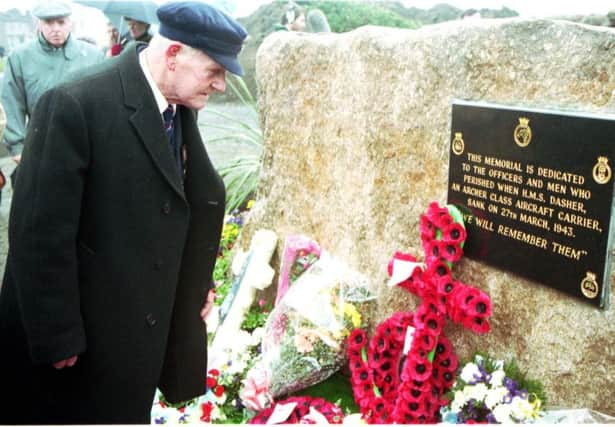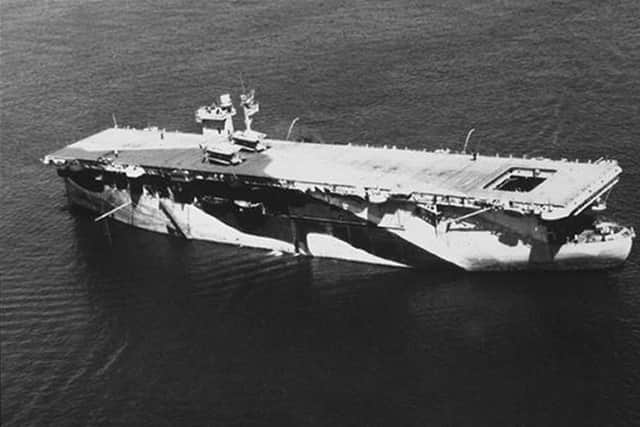Clyde sinking of HMS Dasher continues to puzzle historians


HMS Dasher was originally intended to be an American merchant vessel but was hastily altered to become an aircraft carrier as Britain scrambled to mobilise its defences at the height of the battle for the Atlantic.
Launched in 1941 in New Jersey, she was commissioned into the Royal Navy in July 1942. But just 10 months later the Dasher was devastated by a massive internal explosion while sailing on the Firth of Clyde off the coast of Ardrossan in Ayrshire.
Advertisement
Hide AdAdvertisement
Hide AdThe ship was not under enemy fire and there are no records of German U-Boats or aircraft being in the area at the time.


Dasher was an escort carrier. They were smaller and slower than purpose-built fleet carriers but much cheaper and faster to construct - their principal appeal in wartime.
The Dasher’s naval career was short. She suffered engine trouble while escorting only her second Atlantic convoy and was making her way back to base for repairs when disaster struck.
The sudden explosion on March 27, 1943, sent debris 60ft into the air and coated the sea in burning oil, visible for miles around.
Of 528 crewmen aboard, 379 were killed - despite the rapid deployment of life boats from nearby Brodick and Ardrossan.


‘An accident waiting to happen’
John and Noreen Steele, authors of The Secrets of HMS Dasher, believe the ship was poorly designed and was an accident waiting to happen.
Having moved to Ardrossan from Paisley, the Steeles became interested in the ship’s fate after hearing stories from local residents.
Advertisement
Hide AdAdvertisement
Hide AdThey interviewed numerous survivors of the disaster and browsed previously classified documents in order to better understand the ship’s fate.
The Steeles have long believed the sinking of the Dasher was the subject of an official cover-up.
Their research suggests the ship was never suitable for combat operations. Shortly before its sinking it was found to contravene more than 20 Royal Navy regulations.
“What eventually spelled the end for the ship was its leaking petrol tanks,” John Steele told The Scotsman. “Sometimes the sailors could not return to their cabins due to the fumes. Just one small spark could have triggered the explosion, after which the ship took only eight minutes to sink.”
Of the bodies which were recovered after the HMS Dasher sank, only 24 burials were recorded. No explanation was offered to the families of those who had died, only that they had been killed or were missing.
Steele said he was determined to discover what happened to the 50 or so bodies that have not been accounted for. He added he had “never stopped” working on the case of HMS Dasher since he first published a book on the subject more than a decade ago.
In particular, he continues to look for a rumoured mass grave in which victims were buried.
Advertisement
Hide AdAdvertisement
Hide AdIn 2012, archaeologists won permission to remove top soil at a site in Ardrossan Cemetery in a bid to uncover evidence of a mass burial.
But the team concluded there was nothing to suggest a burial of that nature had taken place at the site.
Operation Mincemeat
The fate of the Dasher’s crew has long made headline news.
In 2004 it was announced one of its crew members may have been ‘The Man Who Never Was’ - the body used to deceive the Germans in Operation Mincemeat, later made famous in a 1956 Hollywood film.
The disinformation strategy was devised in the spring of 1943 by two intelligence officers, Flight Lieutenant Charles Cholmondeley and Commander Ewen Montagu.
The Allies were planning to invade Italy through Sicily from North Africa and Winston Churchill demanded some inspired subterfuge from the Secret Service that would leave the Germans guessing about the true nature of the Allies’ plans.
Flt Lt Cholmondeley and Cdr Montagu dreamed up the idea of planting false papers on an “officer” whose body was then found in the Mediterranean carrying a briefcase padlocked to his wrist with top secret plans that clearly showed the Allies would invade through Sardinia and Greece.
The body had to be given official documents with a cast-iron identity.
Advertisement
Hide AdAdvertisement
Hide AdIn 2004, after years of rumours, relatives of John “Jack” Melville - a sailor killed on the Dasher - were invited to attend a naval memorial service.
It was thought Melville’s body was recovered from the Clyde in 1943 by naval intelligence.
But a BBC documentary has subsequently claimed the body belonged to Glyndwr Michael, an alcoholic Welsh tramp who was found dead in a London warehouse in the winter of 1943.
Whatever the identity of The Man Who Never Was, Operation Mincemeat was hailed as a success and credited with assisting the Allies’ successful invasion of Italy.
Meanwhile, the fate of the Dasher continues to puzzle the many experts who have studied her short naval career.